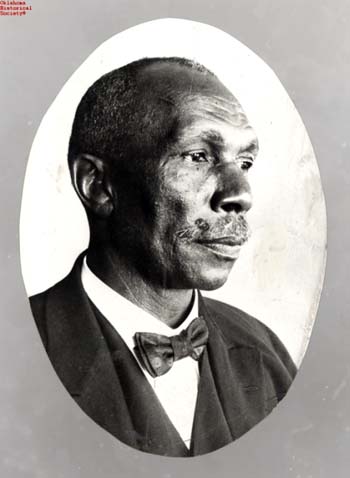The Encyclopedia of Oklahoma History and Culture
PAGE, INMAN EDWARD (1853–1935).
The first president of the Colored Agricultural and Normal University (CANU), later Langston University, and an influential Oklahoma educator, Inman Page was born into slavery on December 29, 1853, in Warrenton, Virginia. During the Civil War his family fled Virginia and later moved to Washington, D.C. Page attended Howard University for two years and then enrolled at Brown University. He was among the first African Americans to be admitted to the prestigious Providence, Rhode Island, college. In 1877 Page and George Washington Milford became the first Blacks to graduate from Brown, with Page selected as class orator for the commencement. He took a teaching position at Natchez Seminary in Mississippi. In 1878 he married Zelia R. Ball, and the couple had two children, Zelia N. and Mary. After one year he left Natchez for Lincoln Institute in Jefferson City, Missouri, and he became the school's president in 1888.
In 1898 the Colored Agricultural and Normal University at the All-Black town of Langston chose Page to be its first president. In his seventeen-year tenure at CANU he increased the school's enrollment from an initial forty to more than six hundred, and its faculty from four to thirty-five. He traveled the state recruiting students, expanded the agricultural and industrial courses, established the college department, and supervised the construction of numerous university buildings. Within a few years partisan politics emerged. By 1915 controversy swirled around the direction of the college's mission from industrial and agricultural education to liberal arts. After scandalous allegations were reported in the Oklahoma Tribune, an Oklahoma City African American newspaper, Page resigned his position and sued. A Logan County jury found the Tribune editor, Melvin Chisum, guilty of libel and one of his employees guilty of extortion against Page. Although the educator was vindicated, the change in administration sent the university into chaos. Enrollment dropped from 639 to 184 for the summer semester and to 322 in the regular term.
Page left the state for a time. He moved back to Missouri as the president of Western College and Industrial Institute at Macon and by 1918 was president of Roger Williams University in Nashville, Tennessee. In 1920 he returned to Oklahoma due to ill health. When recuperated, in 1922 he accepted a position as principal at Oklahoma City's Douglass High School. He soon became the supervising principal of the city's separate school system. Inman Page died on December 21, 1935, at the home of his daughter, Zelia Breaux, in Oklahoma City.
Roscoe Dunjee called Page "the grand old man of education." The city named a park and a school in his honor. Brown University's African American graduates named their association the Inman Page Black Alumni Council. Lincoln University in Jefferson City, Missouri, named the Inman Page Library for him. Langston University commemorated his leadership in Page Hall.
Learn More
Black Dispatch (Oklahoma City, Oklahoma), 26 December 1935.
Willis L. Brown and Janie M. McNeal-Brown, "Oklahoma's First Comprehensive University: Langston University, the Early Years," The Chronicles of Oklahoma 74 (Spring 1996).
Guthrie (Oklahoma) Daily Leader, 8 March 1916.
Zella J. Black Patterson, Langston University: A History (Norman: University of Oklahoma Press, 1979).
Portrait and Biographical Record of Oklahoma (Chicago: Chapman Publishing Co., 1901).
Donald Spivey, "Crisis on a Black Campus: Langston University and its Struggle for Survival," The Chronicles of Oklahoma 59 (Winter 1981–82).
Kaye M. Teall, Black History in Oklahoma: A Resource Book (Oklahoma City, Okla.: Oklahoma City Public Schools, 1971).
Citation
The following (as per The Chicago Manual of Style, 17th edition) is the preferred citation for articles:
Currie Ballard, “Page, Inman Edward,” The Encyclopedia of Oklahoma History and Culture, https://www.okhistory.org/publications/enc/entry?entry=PA005.
Published January 15, 2010
Last updated July 29, 2024
© Oklahoma Historical Society


